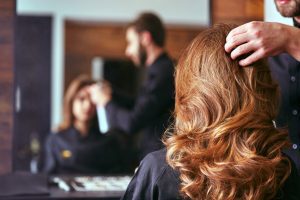Speak Like a Stylist: Helpful Hairstyle Glossary
The worldwide beauty and personal care industry is valued at approximately $400 billion, and it’s easy to see why. All across the globe, stylists, skin care specialists, and beauty brands are helping people just like you feel more confident, radiant, and special. But if you don’t know the jargon, it can be difficult to tell your hair stylist exactly what you’re looking for. Of course, your stylist will conduct a thorough consultation to make sure you’re both on the same page and that the final result will delight you. Still, it may put your mind at ease to gain a better understanding of some of the haircut and styling terms you’ll hear at hair salons. We’ve put together this helpful hairstyle glossary so that you can feel totally self-assured during your next appointment.
-
- Balayage: A highlighting technique that uses a sweeping motion to hand paint color directly onto the hair (no foil necessary). It produces a more natural effect and can be done on various lengths and colors or hair. It generally lasts longer than other types of techniques.
-
- Blunt Cut: A straight-across haircut with no layers that can be done on all lengths of hair. Also known as a “heavy” or “solid” cut.
-
- Consultation: The beginning of a client’s hair service wherein the hair stylist will discuss the look desired by the client and offer expertise. During this time, the client has an opportunity to express what they like, don’t like, or aren’t sure about. The consultation is essential for creating a great experience; even long-time clients should be treated to a thorough consultation at every appointment.
-
- Dry Cutting: This can either be the primary hair cutting method (particularly for clients with curly hair) or as a secondary method after the initial wash, cut, and style. Dry cutting can allow the hair stylist to see more detail and better understand how a client’s hair will lay after styling, which can result in a better cut overall.
-
- Dusting: A very slight trim to clean up a hair cut; “just the very ends.” If a client wants to address only split ends or is nervous to make a bigger change, this can help them feel a little fresher and lighter.
-
- Extensions: Real or synthetic hair pieces that are attached to the client’s hair by braiding, fusing, bonding, or clipping. These pieces can make hair look longer and/or fuller. They may be dyed to match a client’s natural color or can add pops of other colors if desired.
-
- Fringe: Otherwise known as bangs. Face-framing, short layers of hair that sit on the forehead. These can be wispy or piecey, blunt and heavy, or side-swept.
-
- Highlights: Lightening pieces of the hair, rather than the entire head. Highlights can be very thin or chunky, or full (meaning lighter pieces will be selected throughout your hair) or partial (lighter pieces only in specific locations, like underneath layers).
-
- Layers: Cascading shorter pieces of hair that can be blunt or blended in one cohesive haircut. These add volume and dimension to a cut, can help frame the face, or either remove or add weight as needed.
-
- Ombre: The gradual lightening of hair, typically dark at the roots and lighter at the ends. From the French word for “shaded” or “shading.” Unlike balayage, ombre styles have a color contrast between the top and bottom parts of the hair. Ombre styles may require bleaching, depending on the client’s natural hair color.
-
- Texturing: This refers to the process of changing a client’s natural hair texture. Perms add permanent curls or re-shapes existing curls, while relaxers can permanently straighten a client’s hair. These services should allow the hair to stay healthy while giving the client their desired look.
- Undercut: A style in which the top of the hair is left longer than what’s underneath. Bob haircuts may be done in this way, but newer trends involve shaved portions of the head that hide underneath longer portions of hair.
We hope you’ll now feel completely confident to use these terms next time you go to the salon. No matter what kind of final effect you’re after, it’s important to communicate openly with your hair stylist. That way, you’ll leave every appointment feeling incredible.





